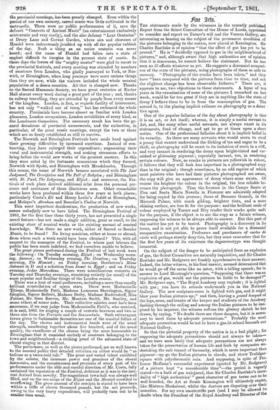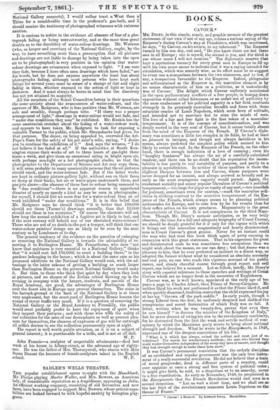$iirt Irto.
Tile statements made by the witnesses in the recently published Report from the Select Committee of the House of Lords, appointed. to consider and report on Turner's will and the Vernon Gallery, are interesting as bearing on the subject of the permanent condition of the pictures belonging to the -nation, now placed at Kensington. Sir Charles Eastlake is of opinion "that the effect of gas has yet to be proved." He is " decidedly opposed to gas in the neighbourhood of pictures," and, although aware that high authorities are of opinion that it is innocuous, he cannot believe the statement. But he has seen no illeffects whatever as yet. He suggests a decennial compari- son of the state of the pictures, using photographs of them as aids to memory. " Photographs of the cracks have been taken," and they have "been compared with the pictures from time to time, and not the slightest change has been observable hitherto." There are, it appears to me, two objections to these statements. A lapse of ten years in the examination of some of the pictures I remarked on last week, would be 'far too great if they are in anything like the state of decay I believe them to be in from the consumption of gas. The second is, to the placing implicit reliance on photography as a detec tive agent.
One of the popular fallacies of the day about photography is that it is an art, or Art itself; whereas, it is simply a useful servant to Art, and, like many other useful servants, not always exact in its statements, fond of change, and apt to go at times upon a short notice. One of the professional fallacies about it is implicit belief in its veracity. As there are many servants who would scorn to steal a penny that cannot understand the filching of tea and sugar to be a theft, so photography will be exact in its imitation of rents in a cliff, and very inexact in rendering the decay upon bright-tinted and var- nished or glistening pigment ; especially inexact, too, in rendering certain colours. Now, as cracks in pictures are yellowish in colour, it follows that they will look less important in a photographed copy than in the original ; though sometimes, by an odd caprice of which most painters who have had their pictures photographed are aware, the copy will give an appearance of decay where none exists. Of course the brighter the colour in the original, the less reliable be- comes the photograph. Thus the frescoes in the Campo Santo at Pisa and Santa Maria Novella in Florence are admirably adapted for being copied by this process; those of Benozzo Gozzoli, in the Riccardi Palace, with much gilding, brighter tints, and a more shining surface, are less fit for the purpose: and the brilliant scale of colour employed by Turner and Etty render their works quite unfit for the purpose, if the object is to use the copy as a future witness, supposing the witness to be always able to answer. But this part.of the matter has yet to be tested. Photography is a discovery in its teens, and is not yet able to prove itself available for a decennial comparative examination. Professors and purchasers of cartes de virile will perhaps stoutly deny this, but they must remember that for the first few years of its existence the daguerreotype was thought immortal.
On the subject of the danger to be anticipated from an explosion of gas, the Select Committee are naturally inquisitive, and Sircharles Nnstlake and Mr. Redgrave are frankly apprehensive in their answers. Indeed, the latter witness, in his final answer, seemed determined that he would go off the scene like an actor, with a telling speech; for in answer to Lord Monteagle's question, "Supposing that there was an explosion-of gas, would not the pictures be liable to be damaged?" Mr. Redgrave says, "The Royal Academy may explode ; it is'lighted with gas ; you have its schools underneath you in the National Gallery. The new sculpture-room is lighted with gas, and it might blow your Italian pictures up;" and then, leaving a grand bouquet of the legs, arms, and trunks of the keeper and students of the Academy dashing through the ceiling and among the Italian pictures to be ima- gined by his inquirer, the witness softens the gloomy sketch he has drawn, 'by saying, " No doubt there are those dangers, but it is neces- sary to meet them by adequate precautions." Probably the most adequate precaution would be not to have a gas-lit school beneath our National Gallery. So that the pictorial property of the nation is in a bad plight ; for supposing the adequate precautions should not always be taken.— and we have seen lately that adequate precautions are not always taken for the preservation of human life and limb .by companies un- dertaking the safe transit of humanity, which is more important-than pigment—up go the Italian pictures in shreds, and strew Trafalgar- square =with polychromatic ruin. And supposing, in spite of Pro- fessor Hoffman's successful experiment (quoted by Mr. Redgrave) of a picture kept " a considerable time"—the period is vaguely stated—in a bath of gas uninjured, that Sir Charles .Eastlake's incre- dulity of " high authorities' " good character of gas turns out to be well founded, the Art at South Kensington will ultimately expire, like Mistress Haekabout, whilst the .doctors are disputin.l' over their remedies. For my own unscientific part (and I may beallowed to doubt when the President of the Royal Academy and Director of the
National Gallery suspects), I would rather trust a West than a Titian for a considerable time in the professor's gas-bath, and I should receive the testimony of photographed witnesses with extreme caution.
It is curious to notice in the -evidence all absence of fear of a pho- tograph fading or being untrustworthy, and at the same time great -doubts as to the durability of .water-colour drawings. Mr. Wornum (who, as keeper and secretary of the National Gallery, ought, by the
way, to have something more than a ,presumption that oil pictures and drawings are not liable to damage by being taken into the open air to be photographed) is very positive 'in his opinion that water- colour drawings are evanescent when exposed to light. " I am sure they fade, because I have often seen drawings which have faded," are
his words, but he does not express anywhere the least fear about photographs fading, although most persons who have kept such things for several years must be aware of a change of tint and slight fading in them, whether exposed to the action of light .or kept •in darkness. And it must always be borne in mind that the discovery has not yet attained its-majority. All the members of the Select Committee betray in their questions the same anxiety about the evanescence of water.colours, and the answers of Mr. Redgrave, who is less positive than Mr. Wornum, are safe and sensible, though perhaps trite. "If there was a proper arrangement of light," drawings in water-colour would not fade, and " under due conditions they may" be exhibited. Mr. Ruskin has the same amateurish crotchet about the fading of a water-colour work, and appears to have taken Mr. Redgrave to task for exposing a valuable Turner to the public, which Mr. Sheepshanks had given for that purpose. The donor, on being appealed to, overruled the Art- Pope's fears for the safety of his pet saint's relic, saying, " I desire you to continue 'the exhibition of it." And, says the witness, " I do not believe it has laded at all." If the authorities at 'South Ken- sington expose their works of art to three hours of gas-light three times a week, and give-them an occasional airing in bright open air, with perhaps sun-light or a hot photographic studio, so that the photographer to the Department of Science and Art may copy them, it will seem probable to many unscientific persons that the oil pictures should crack, and the water-colours fade. But if the latter works are kept in ordinary picture-gallery light, without sun on their faces or damp at their backs, hot air or water-pipes underneath them, and gas-jets above—the absence of these foes to colour being assumed to be " due conditions"—there is no apparent reason to apprehend disaster of nearly so speedy a kind as may be seen in photographs ; for myself, I should feel no more fear for a water-colour than an oil work exhibited "under due conditions." It is in this belief that Mr. Redgrave says lie should thiuk "it is better that 100,000 should see those (Turner's) drawings annually, than that 10,000 should see them in ten centuries." Of course the alarmists will ask how long the annual exhibition of a fugitive art is likely to last, and if the next century will behold any of our cherished water-colours? Those who are not of so death-in-the-pot a temper, will think that our water-colour painters' doings are as likely to be seen by the next century as by Londoners of to-day. The general tendency of the evidence on the question of enlarging
or removing the. National Gallery is towards the advisability of re- moving it to Burlington House. Mr. Pennethorne, who does "not know that quietness is very essential to a National Gallery," thinks that "it would cost full 100,0001. to erect a building there," in the gardens belonging to the house ; which is about the same sum as his proposed additions to the National Gallery would cost, with the ad- vantage in the latter scheme of getting a building as much larger than Burlington House as the present National Gallery would make it. But then to those who think that quiet by day when they look at pictures, and no chance of the Italian school blowing up in the evening in company with the keeper, students, and models of the Royal Academy, are good, the advantages of Burlington House over the finest site in Zurepe may present themselves. The noise in the barrack-ground at the 'back of the National Gallery is at times very unpleasant, but the court-yard of Burlington House lessens the sound of street traffic very much. If it is a question of removing the National Gallery -or the Royal.Academy to Piccadilly, the public would most probably prefer to have the enjoyment of quiet when they inspect their pictures ; and with those who wish the safety of our collection for the sake of our descendants as well as present plea- sure for themselves, the chances of explosion ofgas will far outweigh all selfish desires to see the collection permanently open at night.
The report is well worth public attention, as it is on a subject of general interest; it is, purchasable for a trifle, and is not at all dull.
W. P.
John Francis—a sculptor of respectable attainments—died last week at his house in Albany-street, at the advanced age of eighty- one. He was the father of Mrs. Thorneyeroft, who shares with Miss Susan Dumnt the.honours of female-sculpture talent in the English































 Previous page
Previous page